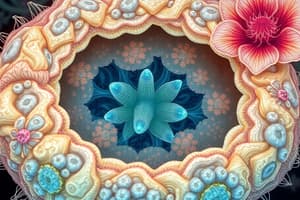Podcast
Questions and Answers
What is the primary function of the mitochondria in cells?
What is the primary function of the mitochondria in cells?
- Protein synthesis
- Storing genetic material
- Providing energy to the cell through aerobic respiration (correct)
- Regulating cell growth
What is the main difference between plant and animal cells?
What is the main difference between plant and animal cells?
- Presence of cytoplasm
- Presence of a nucleus
- Presence of a cell wall (correct)
- Presence of mitochondria
What is the function of the cell membrane?
What is the function of the cell membrane?
- To control which substances can pass in and out of the cell (correct)
- To store genetic material
- To synthesize proteins
- To provide energy to the cell
What is the function of chlorophyll in plant cells?
What is the function of chlorophyll in plant cells?
What is the main characteristic of prokaryotic cells?
What is the main characteristic of prokaryotic cells?
What is the function of ribosomes in cells?
What is the function of ribosomes in cells?
What is the function of the nucleus in cells?
What is the function of the nucleus in cells?
What is the main function of the cytoplasm in cells?
What is the main function of the cytoplasm in cells?
How many cells are present in an adult human?
How many cells are present in an adult human?
What is the function of the vacuole in plant cells?
What is the function of the vacuole in plant cells?
Flashcards are hidden until you start studying
Study Notes
• Cells are the basic building blocks of life, and they are the smallest unit of life that can replicate independently. • Cells are the smallest units of life that can divide into new cells, and in multicellular organisms like animals and plants, this division leads to growth or replacement of dead cells. • An adult human contains over 40 trillion cells, which are divided into hundreds of different types, such as skin cells, blood cells, and more. • Cells are surrounded by a cell membrane that controls which substances can pass in and out of the cell. • Both animal and plant cells have a nucleus that contains the genetic material or DNA of the cell, controlling the cell's activities. • Both types of cells are filled with a gel-like substance called cytoplasm, where chemical reactions take place and other subcellular structures are suspended. • Mitochondria are present in both animal and plant cells, providing energy to the cell through aerobic respiration. • Ribosomes are also present in both types of cells, serving as the site of protein synthesis. • Plant cells have additional structures, including a rigid cell wall made of cellulose, a permanent vacuole containing cell sap, and chloroplasts where photosynthesis occurs. • Chloroplasts contain chlorophyll, a green substance that absorbs light energy for photosynthesis, making plant leaves green. • Bacterial cells are prokaryotic, consisting of a single cell, and lack mitochondria, chloroplasts, and a nucleus. • Bacterial cells have a cell membrane, cell wall, ribosomes, and cytoplasm, but their genetic material is a single circular strand of DNA that floats in the cytoplasm. • Some bacteria have additional small rings of DNA called plasmids, which carry extra genes like antibiotic resistance. • Some bacteria also have flagella, thread-like structures that allow them to move around.
Studying That Suits You
Use AI to generate personalized quizzes and flashcards to suit your learning preferences.



